DNA TESTING
INHERITED DISEASES
These are affectations that are passed down from generation to generation.
- The origin is caused by some changes in the genetic information of the dogs.
- Dogs may be carriers but not present the disease

DNA Genetic testing
- Basic genetic terms and definitions
- Basic concept of genetic inheritance in dogs
- 2 technologies available
- Analysis process
- How to analyse results and actions to take
- Learning about genetics
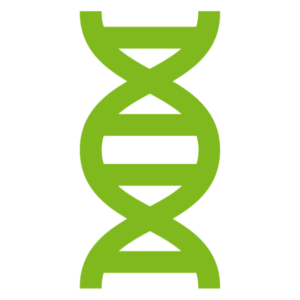
Basic genetic terms & definitions
- Chromosomes Thread-like, gene-carrying bodies in the nucleus of a cell. Chromosomes are composed primarily of DNA and protein. They are visible only under magnification during certain stages of cell division

- Genes / Locus units of inheritance usually occurring at specific locations, or loci, on a chromosome. Physically, a gene is a sequence of DNA bases that specify the order of amin acids in an entire protein or, in some cases, a portion of a protein. A gene may be made up of hundreds of thousands of DNAbases. Genes are responsible for the hereditary traits in plants and animals.

- Alleles alternate forms or varieties of a gene.The alleles for a trait occupy the same locus or position on homologous chromosomes and thus govern the same trait. However, because they are different, their action may result in different expressions of that trait

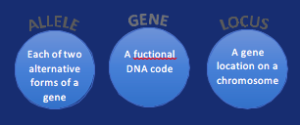
2 allèles of the same gene can be identical or different
HOMOZYGOUS
- Presence of two identical alleles at a particular gene locus

HETEROZYGOUS
- State of having two different alleles of a particular gene
- State of having inherited different forms of a particular gene from each one of your biological parents

An allele can be Dominant / Recessive
- Dominant allele
an allele that masks the presence of a recessive allele in the phenotype. Dominant alleles for a trait are usually expressed if an individual is homozygous dominant or heterozygous
- Recessive allele
an allele that is masked in the phenotype by the presence of a dominant allele. Recessive alleles are expressed in the phenotype when the genotype is homozygous recessive (aa).
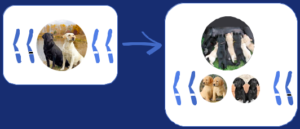
Phenotype results from Genotype

- Phenotype
the observable or detectable characteristics of an individual organism the detectable expression of a genotype

- Genotype
he genetic makeup of an individual. Genotype can refer to an organism’s entire genetic makeup or the alleles at a particular locus.
- The phenotype is the result of the genotype


Basic Concept of Genetic inheritance in dogs
- Gene pool
all of the genes in all of the individuals in a breeding population. More precisely, it is the collective genotype of a population.
- Gene flow
the transference of genes from one population to another, usually as a result of migration. The loss or addition of individuals can easily change the gene pool frequencies of both the recipient and donor populations–that is, they can evolve.
- Genetic diversity
The greater the number of alleles that are available at each gene pair (called genetic polymorphism), the greater the genetic diversity of the breed. If there is no breed diversity in a gene pair, but the particular homozygous gene that is present is not detrimental, there is no negative effect on breed health.
- Inbreeding
Inbreeding occurs when puppies are produced from two related dogs, i.e. dogs with relatives in common. High levels of inbreeding can affect the health of these puppies.
We do know that the higher the degree of inbreeding, the higher the risk is of the puppies developing both known and unknown inherited disorders. Inbreeding can also have an impact on the breed as a whole, e.g. reducing litter sizes and fertility.
A FEW NUMBERS

What are SNPs?
Around 20,000 genes in the canine genome 

SNPs
6,000,000 SNPs in Dogs among 2,400,000,000 base pairs



2 technologies available
Microsatellites (STR Short Tandem repeat) vs
SNP (Single Nucleotide Polymorphism)


Analysis process
How does it work on a technologic view
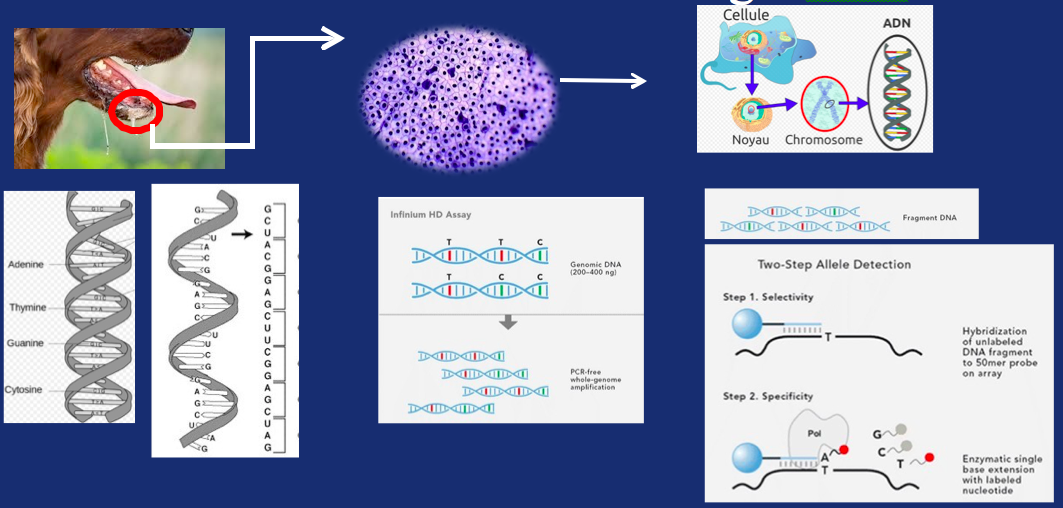
DNA ILLUMINA CHIP
The chip contains 200 000 SNPs to be tested

- 16,000 for diversity measurement and breed assignment
- 201 for disease mutations
- 800 for risk conferring effect
- 35 for traits
![]()

How to analyse results and actions to take
The goal is to provide basis to support Good Breeding Practices!


What If the Dog is at risk?
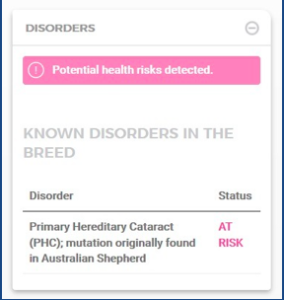
- Important for planning the best care
- Following up on the symptoms – predicting the onset
- Screening prior to medical intervention for bleeding disorders or potential inherited oversensitivities to commonly
- used drugs
- Remove the dog from reproduction if the allele is dominant

What if the Dog carries a disease?
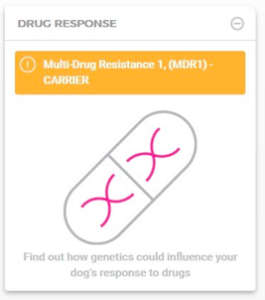
- Essential background for sustainable breeding plans à Take care of the other reproductive status for this specific disorder
- In some cases may still cause milder symptoms

When everything is clear


- Fantastic news, no detected risks regarding health, medical care, breeding selection or drug response!
Good Care instructions make it actionable!


Learning about Genetics
Let’s meet Clare, a Labrador breeder, on how to unlock the secrets of Genetics.
First, some basic knowledge: what is a chromosome? a gene? the DNA? an allele? But also, what does homozygous and heterozygous, phenotype and genotype mean?
Then, through concrete examples you will help Clare select dogs for mating and understand to what extent she can predict the colors of each puppy in the coming litter.
The DNA tests will have no more secret for you: you will understand what a major and healthy role DNA can have in breeding well-balanced puppies.
Enter in this new Era by clicking the link below and discover how much Genetics is fantastic!
